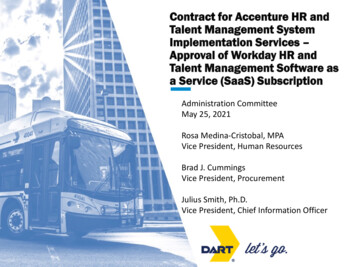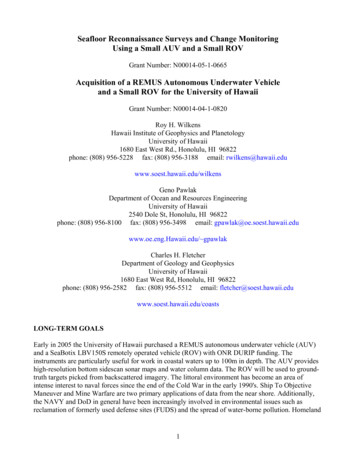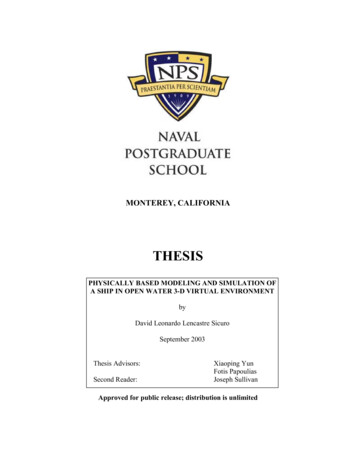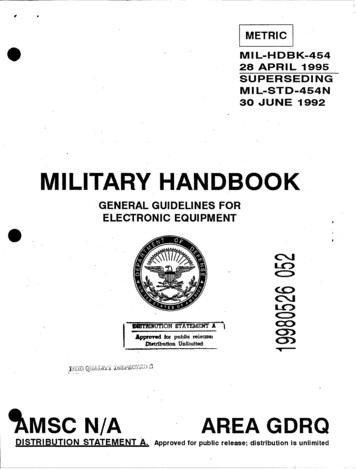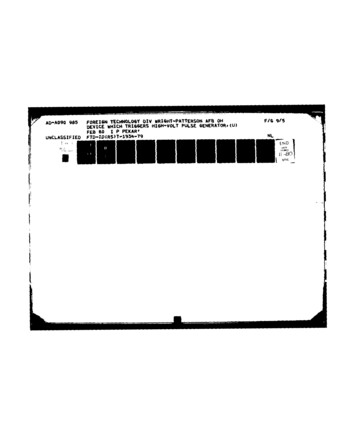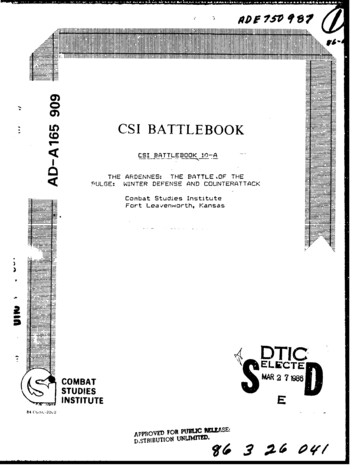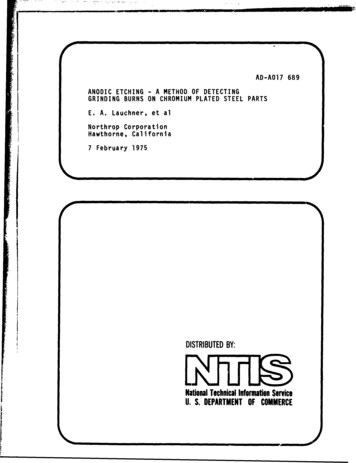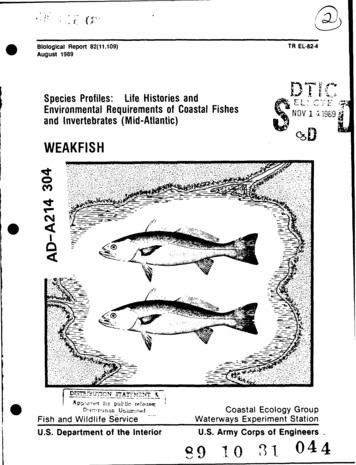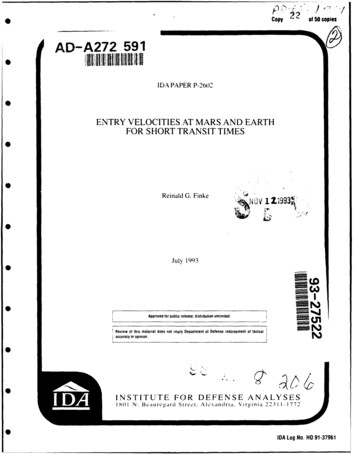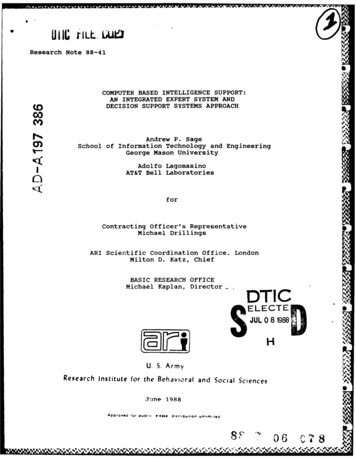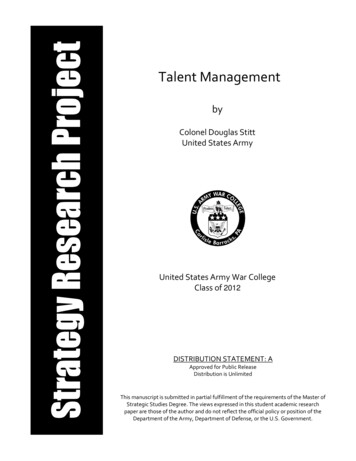
Transcription
Talent ManagementbyColonel Douglas StittUnited States ArmyUnited States Army War CollegeClass of 2012DISTRIBUTION STATEMENT: AApproved for Public ReleaseDistribution is UnlimitedThis manuscript is submitted in partial fulfillment of the requirements of the Master ofStrategic Studies Degree. The views expressed in this student academic researchpaper are those of the author and do not reflect the official policy or position of theDepartment of the Army, Department of Defense, or the U.S. Government.
The U.S. Army War College is accredited by the Commission on Higher Education of the Middle StatesAssociation of Colleges and Schools, 3624 Market Street, Philadelphia, PA 19104, (215) 662-5606. The Commissionon Higher Education is an institutional accrediting agency recognized by the U.S. Secretary of Education and theCouncil for Higher Education Accreditation.
Form ApprovedOMB No. 0704-0188REPORT DOCUMENTATION PAGEPublic reporting burden for this collection of information is estimated to average 1 hour per response, including the time for reviewing instructions, searching existing data sources, gathering and maintaining thedata needed, and completing and reviewing this collection of information. Send comments regarding this burden estimate or any other aspect of this collection of information, including suggestions for reducingthis burden to Department of Defense, Washington Headquarters Services, Directorate for Information Operations and Reports (0704-0188), 1215 Jefferson Davis Highway, Suite 1204, Arlington, VA 222024302. Respondents should be aware that notwithstanding any other provision of law, no person shall be subject to any penalty for failing to comply with a collection of information if it does not display a currentlyvalid OMB control number. PLEASE DO NOT RETURN YOUR FORM TO THE ABOVE ADDRESS.1. REPORT DATE (DD-MM-YYYY)2. REPORT TYPE22-03-2012Strategy Research Project3. DATES COVERED (From - To)4. TITLE AND SUBTITLE5a. CONTRACT NUMBERTalent Management5b. GRANT NUMBER5c. PROGRAM ELEMENT NUMBER6. AUTHOR(S)5d. PROJECT NUMBERColonel Douglas F. Stitt5e. TASK NUMBER5f. WORK UNIT NUMBER7. PERFORMING ORGANIZATION NAME(S) AND ADDRESS(ES)8. PERFORMING ORGANIZATION REPORTNUMBERColonel(Retired) George WoodsDepartment of Military Strategy, Planning, and Operations10. SPONSOR/MONITOR’S ACRONYM(S)9. SPONSORING / MONITORING AGENCY NAME(S) AND ADDRESS(ES)U.S. Army War College122 Forbes AvenueCarlisle, PA 1701311. SPONSOR/MONITOR’S REPORTNUMBER(S)122DISTRIBUTIONForbes Avenue12./ AVAILABILITY STATEMENTDistribution: A122Forbes AvenueNOTES13. SUPPLEMENTARYCarlisle, PA 1701314. ABSTRACTThere is a demonstrated link between successful global corporations and their application and use of talent managementpractices. Incorporating aspects of talent management practices may provide the United States Army the requisite ways toretain its competitive advantage in the complex and uncertain twenty-first century security environment. The purpose of thispaper is to outline the concept of talent management as a way for the United States Army to manage its officer corps and setthe conditions for success in the twenty-first century. Exploring the civilian sector first demonstrates current and successfultalent management strategies and systems in place. Examination of the current United States Army officer managementpolicies demonstrates a requirement to study the possible inclusion of several talent management concepts used in thecorporate world.15. SUBJECT TERMSHuman Capital, Officer Management16. SECURITY CLASSIFICATION OF:17. LIMITATIONOF ABSTRACTa. REPORTb. ABSTRACTc. THIS PAGEUNCLASSIFEDUNCLASSIFEDUNCLASSIFEDUNLIMITED18. NUMBEROF PAGES19a. NAME OF RESPONSIBLE PERSON3019b. TELEPHONE NUMBER (include areacode)Standard Form 298 (Rev. 8-98)Prescribed by ANSI Std. Z39.18
USAWC STRATEGY RESEARCH PROJECTTALENT MANAGEMENTbyColonel Douglas StittUnited States ArmyDr. George WoodsProject AdviserThis SRP is submitted in partial fulfillment of the requirements of the Master of StrategicStudies Degree. The U.S. Army War College is accredited by the Commission onHigher Education of the Middle States Association of Colleges and Schools, 3624Market Street, Philadelphia, PA 19104, (215) 662-5606. The Commission on HigherEducation is an institutional accrediting agency recognized by the U.S. Secretary ofEducation and the Council for Higher Education Accreditation.The views expressed in this student academic research paper are those of the authorand do not reflect the official policy or position of the Department of the Army,Department of Defense, or the U.S. Government.U.S. Army War CollegeCARLISLE BARRACKS, PENNSYLVANIA 17013
ABSTRACTAUTHOR:Colonel Douglas StittTITLE:Talent ManagementFORMAT:Strategy Research ProjectDATE:22 March 2012KEY TERMS:Human Capital, Officer ManagementWORD COUNT: 5483PAGES: 30CLASSIFICATION: UnclassifiedThere is a demonstrated link between successful global corporations and theirapplication and use of talent management practices. Incorporating aspects of talentmanagement practices may provide the United States Army the requisite ways to retainits competitive advantage in the complex and uncertain twenty-first century securityenvironment. The purpose of this paper is to outline the concept of talent managementas a way for the United States Army to manage its officer corps and set the conditionsfor success in the twenty-first century. Exploring the civilian sector first demonstratescurrent and successful talent management strategies and systems in place.Examination of the current United States Army officer management policiesdemonstrates a requirement to study the possible inclusion of several talentmanagement concepts used in the corporate world.
TALENT MANAGEMENTAll organizations now say routinely, “People are our greatest asset.” Yetfew practice what they preach, let alone truly believe it.—Peter Drucker1The operational environment of the 21st century calls for a different kind of war.Retired British General officer Rupert Smith outlines what such a conflict may look likein his work, “The Utility of Force.” General Smith describes a new type of war, a war notbetween the forces of nation states, but a conflict of people. Smith speaks of war as“the reality in which the people in the streets and houses and fields-all the people,anywhere- are the battlefield.”2 The objectives of this new war align with individuals orgroups, not states.3 Two important aspects of this type of war are an omnipresentmedia, bringing the fight home to any screen anywhere in the world. The other is thetemporal characteristic of conflict, where time is almost suspended until conditions aremet, vice the defeat of a static enemy.4 The requirements to set these conditions maynecessitate years and decades. Rupert Smith’s description of the future environmentand the type of conflict conducted within this environment, in turn requires a strategyand a land force capable of operating in this milieu. In the U.S. Army War College’slexicon the “VUCA” environment of volatility, uncertainty, complexity and ambiguity is anapt description of the environmental framework for this type of war.5 This “VUCA”environment and future conflict described by Rupert Smith requires a strategy and landforce capable of operating in this milieu.Recently the National Command Authority of the United States released itsDefense Strategic guidance. The President of the United States’ opening commentaryto the strategic guidance highlighted the need to move the military through a period of
transition while simultaneously focusing national efforts to build the strength and viabilityof the United States economy.6 President Obama, as the Commander in Chief, directedthe development of a defense enterprise which meets the challenges of the 21st centurybut also aligns itself within the fiscal constraints of the struggling United Stateseconomy.The strategic review answers President Obama’s requirement by providing adefense strategy focused primarily on transitioning from the conduct of today’s COINfocused campaigns in Iraq and Afghanistan and preparing for the challenges oftomorrow.7 A prime factor in the Department of Defense’s ability to transform also restson its ability to “rebalance and reform, and support the national security imperative ofdeficit reduction through a lower level of defense spending.”8 The strategic documentoutlines the primary missions of the United States Armed Forces and caveats therequirement for a range of capabilities required to accurately and effectively understandand operate within the current strategic environment. Therefore, there is an operationalnecessity for agility, flexibility, and versatility within the Defense enterprise toaccomplish a broad array of missions, ranging from humanitarian and disaster relief topower projection in order to conduct conventional operations.9 Further underlying thestrategy is the requirement for the Department of Defense to continue to cut costs andfind efficiencies, including manpower, in order to create a force supportable by ournation’s finances.10The broad range of missions is compatible with the environment of future conflictdescribed by Rupert Smith. One of the implied principles outlined in the strategy is therequirement for a smaller force, one comprised of individuals who possess a wide2
sphere of talent and skills to meet these challenges. The United States Army’s portionof this strategy must support the accomplishment of the overall strategy and nest withthe concepts and missions outlined by the Department of Defense. The Armyleadership must in turn develop a smaller and viable human force mix to meet thenation’s strategic end state.In his “Marching Orders”, General Raymond Odierno, the Chief of Staff of theUnited States Army (CSA), outlined his intent to successfully operate within thecomplexities of the current and future environments while reducing the force within fiscalconstraints placed upon the Army.11 General Odierno’s intent is to: 1) win the currentfight; 2) develop a versatile mix of capabilities, formations, and equipment; 3) preserveour high quality All-Volunteer Force; 4) foster a continued commitment to the ArmyProfession; and, 5) continue to adapt our leader development programs.12 He positedthat vital to downsizing the force was the manner in which the United States reduces itsforce while retaining personnel with the qualities and capabilities earned over the past10 years of conflict.13 Retaining these quality personnel while simultaneously executingpersonnel cuts is a challenging proposition.The five priorities provided by the CSA requires leaders to execute thesemissions within the framework of fiscal constraints and intricacies of the twenty-firstcentury strategic environment. General Odierno stated that the Army, “must developleaders who are adaptable and flexible in solving complex problems.”14 The CSA’srequirement to develop adaptable and flexible leaders, capable of operating in acomplex environment and accomplishing a broad sphere of missions with a smallerforce, calls for a new leadership management approach. A way to transform its current3
approach is through the application of a common business practice known as “talentmanagement.”There is a demonstrated link between successful global corporations and theirapplication and use of talent management practices. Incorporating aspects of talentmanagement practices may provide the United States Army the requisite ways to retainits competitive advantage in the complex and uncertain twenty-first century securityenvironment.The purpose of this paper is to outline the concept of talent management as away for the United States Army to manage its officer corps and set the conditions forsuccess in the twenty-first century. Exploring the civilian sector first demonstratescurrent and successful talent management strategies and systems in place.Examination of the current United States Army officer management policiesdemonstrates a requirement to study the possible inclusion of several talentmanagement concepts used in the corporate world. Thus a hybrid system is thenachieved, building on current officer management principles and policies, whileincluding some of the current use of talent management practices.What is Talent Management and How Does Business Utilize This Concept?In an ends, ways and means framework, talent management is a way successfulcompanies and corporations maintain their competitive advantage in the globaleconomic commons. Competitive advantage is the “what” that distinguishes onebusiness from its competition. Competitive advantage is what businesses strive toachieve over their competitors. This section of the paper provides: a definition of talentmanagement; the direct, senior level corporate leadership involvement in talent4
management; and the necessity to connect talent management and corporate strategyin order to achieve successful business outcomes and obtain competitive advantage.Talent management is a field within current business literature and its usethroughout corporate America describes many aspects of human resourcemanagement. The meaning of talent management is subject to debate andinterpretation:A casual review of the trade and popular literature on the topic of “talentmanagement” (TM) would certainly lead one to conclude it is a popularand growing field Given the number of consulting firms engaging intalent management and the growing number of articles and books on thetopic, one might also believe “talent management” to be a well-definedarea of practice supported by extensive research and a core set ofprinciples.15There are many definitions for talent management, ranging from “the strategic setof integrated business processes which manage the planning, acquisition, development,retention and advancement of talent to achieve business goals and optimizeperformance”16 to “managing the supply, demand, and flow
Talent Management by Colonel Douglas Stitt United States Army United States Army War College Class of 2012 DISTRIBUTION STATEMENT: A Approved for Public Release Distribution is Unlimited This manuscript is submitted in partial fulfillment of the requirements of the Master of Strategic Studies Degree. The views expressed in this student academic research paper are those of the author and do not .
